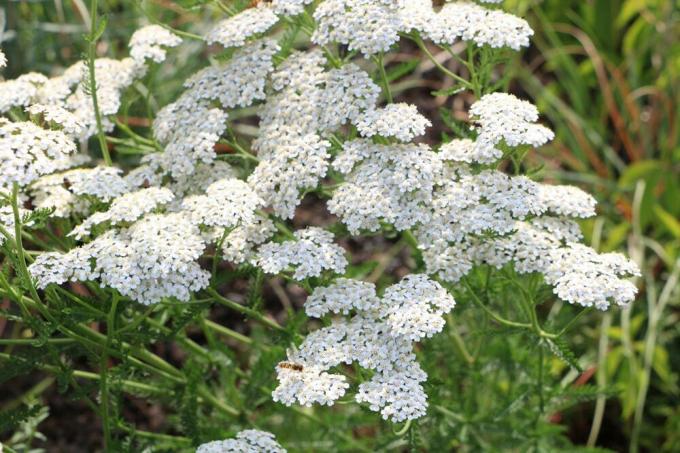

Table of contents
- winter break
- winter fertilizer
- Tips for winter fertilizer application
- handling in winter
Ice and snow demand a lot from lawns. Consequently, they must be well prepared for the winter months. Fertilizing is definitely part of it. However, this fertilization must already be done in autumn and definitely before the first frost. It must also not stimulate growth. In addition, further care measures are necessary if there is to be a lot of magnificent green in the garden again in spring.
winter break
Like most other plants, grass stops growing during the winter months. The time is used for regeneration - and to recharge your batteries for the new growth period in spring. At the same time, however, lawns are exposed to considerable stress when there is no vegetation. One could think of ground frosts or a closed blanket of snow. So that a lawn can survive this as unscathed as possible, it should be able to start the winter break well strengthened. For this it is necessary to fertilize it in time. In this case, timely means above all that the fertilizer must be applied before the first frost and the first snow. As a rule, the so-called winter fertilization is therefore more of an autumn fertilization, which should be done by mid-November at the latest, depending on the weather.
A notice:
To prevent major damage, a lawn should not be walked on during the winter months. The risk of blades of grass being badly damaged is too great.
winter fertilizer
However, not only the time but also the type of fertilizer is of crucial importance for the correct fertilization in autumn. Again, the weed goes on hibernation for several months. So it's not growing. Consequently, it also makes no sense to use nitrogenous or administer nitrogen-rich fertilizer, which is known to promote growth. Instead, at this point in time, you rely entirely on a fertilizer that is as rich in potassium as possible. It causes the salt content in the cell sap of the grass to increase. However, a higher salt content minimizes the risk of the cells freezing and thus being damaged. Potassium-rich fertilizers act like a kind of frost protection for the lawn:
A notice:
The trade has special ready-made mixtures that are designed to provide lawns with as much potassium as possible for the winter.
Tips for winter fertilizer application

The first thing to do is to get the right fertilizer for autumn fertilization. Then you need the right time. You should know that fertilization alone is usually not sufficient. The following tips also help to get the lawns in the garden through the cold season:
- Before the start of the winter months, it is best to supply the lawn twice with a fertilizer with a high potassium content. A first fertilization can be done at the beginning of October, for example, and the second around four weeks later, i.e. at the end of October or September. Beginning of November.
- Always apply fertilizer over a large area and well distributed. Diligence is particularly important here. If possible, the entire lawn area should be covered with it. Any defects are often noticeable in the coming year as brown spots in the green.
- Under no circumstances should fertilizer left over from the summer be used at this time. If there are still fertilizer residues, it is best to save them for the coming spring. Fertilizer does not normally spoil or does not lose its effectiveness so quickly.
- Even with the administration of special winter fertilizer, the dosage recommendation must be observed. The problem here is not so much too much potassium, but the fact that this fertilizer also contains a certain, albeit small, amount of nitrogen. If you give too much, there is a great danger of over-fertilization. In addition, growth is stimulated during the dormant phase in winter of all times.
- Before the first fertilization or at the latest between the two autumn fertilization processes, the lawn should be thoroughly cared for and brought into shape. For example, it is advisable to free it from the moss or to remove the leaves that have come to rest on it. It is simply fundamentally important that the soil is well drained. Only then can the fertilizer really develop its effect.
handling in winter
Blades of grass should be treated like raw eggs during the winter months. They are particularly sensitive during this time and, above all, can break very easily. This also applies if they are not frozen. Children frolicking or building a snowman on the snowy lawn is a nightmare for the grass. The damage that can result from this is usually enormous. As a rule, there is no way around overseeding various spots in the lawn in the spring. It always makes more sense to allow children to have fun in and with the snow on a driveway. In any case, no plants can be harmed there. The more the lawn is left alone during the vegetation break, the more magnificently it will unfold again in the spring.
 garden editorial
garden editorial I write about everything that interests me in my garden.
Learn more about lawn care

Sanding the lawn: how much sand per m²?
The lawn is the focal point of the garden. Sanding the lawn can effectively influence its appearance. However, there are a few things to consider, because too much of it can also damage the green. Read here how much sand you should apply per m² when sanding the lawn.

Overseed the lawn without scarifying?
Which hobby gardener doesn't dream of a dense, lush green lawn? Bald spots not only look unsightly, they also encourage weed growth. But can you overseed a lawn without scarifying it first?

Recognize and fight couch grass successfully | 10 tips
Couch grass is one of the most stubborn weeds. However, there are also differences here, because not every species becomes a problem in the garden. However, if the creeping or common couch grass is up to mischief, you can take action against it with perseverance and the right techniques.

Iron fertilizer: the right use in the lawn
Iron fertilizer supplies the lawn and works against moss. However, it has to be used correctly. Therefore, observe the following tips to achieve optimal results for the grass plants and to avoid damage to the meadow.

Does coffee grounds help against clover in the lawn?
Clover in the lawn is a nuisance that many garden owners struggle with. Lawns, which in some cases are interspersed with numerous nests, are often affected. As an alternative to chemical agents, many wonder whether coffee grounds are effective against weeds.

Yarrow in the lawn | How do I get rid of yarrow?
There is no question that yarrow is one of the best-known medicinal herbs. It helps against colds and is used for skin diseases and gynecological problems. On the manicured lawn, she is seen as a troublemaker. How do you get rid of them? Are there effective alternatives to the chemical club?


